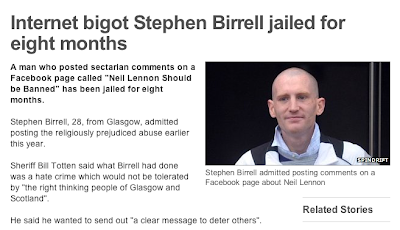
Students were introduced to Reception Theory and the philosophy of Jean Baudrillard with specific reference to his view that the media has created a HYPERREALITY.
Students were introduced to the idea of Moral Panics and media regulation.Below is a link to the Mark Kermode clip that I presented to the class. Kermode is a wonderfully engaging film critic and I would advise all students to visit his blog:
http://www.bbc.co.uk/blogs/markkermode/2009/06/moralpanic_150609.htmlThe class discussed the definition of Moral Panic and the discussion moved into a consideration or regulation and why media needs regulating. This discussion involved the class being shown the following clip from the film 'The Life of Brian' and a consideration of why this film was banned by some UK local councils when it was released in 1979. Ireland and Norway refused permission to broadcast this film. WHY?:
http://www.youtube.com/watch?v=1loyjm4SOa0The class were shown two adverts that have been banned by the ASA.Click on link to access the OPIUM and DFS adverts:
http://www.youtube.com/watch?v=uvBVUit3kjYhttp://www.youtube.com/watch?v=at1y7iHmjXQHere are some articles that explain why these advertisements were banned:
http://www.bbc.co.uk/news/uk-12336061http://news.bbc.co.uk/1/hi/business/7762337.stmReference was made to Jo Swinson, the Liberal Democrat MP, and her opinions relating to digital image manipulation. She has challenged the morality of digital image manipulation and is a very interesting media voice. Click on link below to develop an understanding of Swinson's views:
http://www.youtube.com/watch?v=eKMy-9w17a8This is a speech she gave to Parliament titled: The effect of media images on the body of women and girls. ALL STUDENTS SHOULD LISTEN TO THIS SPEECH.
Below is an example of image manipulation that was banned by the ASA. This OLAY advert was considered to be 'too airbrushed.':
http://www.bbc.co.uk/newsbeat/14308714The class discussion considered why these advertisements could be considered controversial and were introduced to the Women's Aid advertisement CUT that was released in 2009. The CLEARCAST regulatory organisation considered this film unsuitable for television unless the final scenes received a massive re-edit. Women's Aid refused to re-edit their film and decided to broadcast the film online and in cinemas accompanied by a print campaign. There was a 50% rise in contributions to the charity after this film and print campaign. Was the CLEARCAST decision the correct decision? Students were asked to consider the following questions:
- Who has the power to regulate media?
- Why do we need protection from media?
- Who are the institutions with the power to regulate media?
- How does regulation relate to media theory?
Below is the link to the Women's Aid CUT film:
http://www.youtube.com/watch?v=j4RjsqPYaS0Students were offered the first five minutes of Stan Kubrick's 'A Clockwork Orange' and asked to consider why Kubrick made the decision to censor his own film.
Finally the class were shown the BBC advertisement for Sherlock Holmes and asked to provide a media analysis to this text appropriate for MEST3 Section A.
HOMEWORK: Students should produce an A4 revision sheet for their fellow media comrades. All students were provided with a research topic and I expect to receive this A4 sheet next week. The three students who missed this session need to see me to receive their topic task. Topics offered to the students included:
- OFCOM
- THE HAYS CODE
- THE ADVERTISING STANDARDS AUTHORITY
- THE BRITISH BOARD OF FILM CLASSIFICATION
- ISSUES RELATING TO MANHUNT 2
- MEDIA ISSUES LINKED TO JO SWINSON AND HER CAMPAIGN AGAINST IMAGE MANIPULATION
- THE DIGITAL ECONOMY ACT
- MEDIA ISSUES LINKED TO THE JUDAS PRIEST TRIAL IN 1990.
- MEDIA ISSUES LINKED TO THE FILM 'A CLOCKWORK ORANGE'
The aim of this research task is to make students aware of who regulates our media and make students aware of their regulatory power. All students need to illustrate their work with specific examples of regulation or accusations against the influence of a film/game. ALL this information will inform student understanding of the first section of MEST3 and student coursework.
Students also need to familiarise themselves with the following texts as students will be providing an MEST 3 Section A response to these texts in next week's session:
Dexter introduction:
http://www.youtube.com/watch?v=fhKRhk49iqQSherlock Holmes advertisement:
http://www.youtube.com/watch?v=cSQq_bC5kIwThe questions you will be asked to consider next week are:
- How are media forms used to represent the central character?
- Why do we watch media that deals with such disturbing material?
The second question will ask you to consider media theory so students need to digest DYER'S theories that I gave you in today's session and you also need to revisit THE USES AND GRATIFICATION THEORY. The second question will test your understanding of media theory and you will be expected to refer to other media texts.
Phew. Lots to do.















































